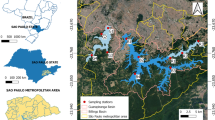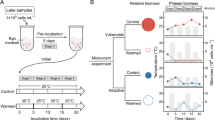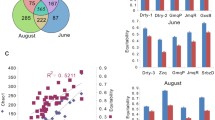Abstract
Unlike the extensive research on the response of soil microorganisms to high ambient temperature (HTA), the response of sediment microorganisms to HTA remains unclear. Understanding the response of sediment microorganisms to HTA is important to forecast their impacts on ecosystems and climate warming under projected climate change scenarios. Against the background of climate warming and frequent high ambient temperatures in summer, we conducted a laboratory incubation experiment to clarify the unique assembly characteristics of pond sediment bacterial communities at different temperatures (4, 10, 15, 25, 30 and 35 °C). The results showed that the structure and function of the microbial community in pond sediments at 35 °C were different from those under other temperatures; the microbial community structure at 35 °C had the most large modules and an average module size. Temperature and dissolved oxygen influenced the microbial community network modularity. The CO2 emission rates of pond sediments at 35 °C were significantly higher than those at other temperatures. At 35 °C, heterogeneous selection was the most important assembly process. Additionally, warming altered the microbial network structure and ecosystem functioning but not the microbial diversity or community composition, which may be related to horizontal gene transfer. Revealing the rapid response of pond sediment microorganisms to HTA is important for identifying their role in nutrient cycling and assessing the ecological impacts of climate warming and high ambient temperatures on inland water sediments.








Similar content being viewed by others
Data availability
The data supporting the findings of this study are available within the article and/or its supplementary materials.
References
Ai H, Qiu Y, He Q, He Y, Yang C, Kang L, Luo H, Li W, Mao Y, Hu M, Li H (2019) Turn the potential greenhouse gases into biomass in harmful algal blooms waters: a microcosm study. Sci Total Environ 655:520–528
Banerjee S, Schlaeppi K, Heijden, M.G.A.v.d., (2018) Keystone taxa as drivers of microbiome structure and functioning. Nat Rev Microbiol 16:567–576
Bérard A, Bouchet T, Sévenier G, Pablo AL, Gros R (2011) Resilience of soil microbial communities impacted by severe drought and high temperature in the context of Mediterranean heat waves. Eur J Soil Biol 47(6):333–342
Chen IC, Hegde U, Chang CH, Yang SS (2008) Methane and carbon dioxide emissions from closed landfill in Taiwan. Chemosphere 70(8):1484–1491
Chen ZJ, Xu G, Ding CY, Zheng BH, Chen Y, Han H, Li YY, Shi JW, Hu LQ (2020) Illumina MiSeq sequencing and network analysis the distribution and co-occurrence of bacterioplankton in Danjiangkou Reservoir, China. Arch Microbiol 202(4):859–873
Colby GA, Ruuskanen MO, St Pierre KA, St Louis VL, Poulain AJ, Aris-Brosou S (2020) Warming climate is reducing the diversity of dominant microbes in the largest high arctic lake. Front Microbiol 11:561194
Comer-Warner SA, Romeijn P, Gooddy DC, Ullah S, Kettridge N (2018) Thermal sensitivity of CO2 and CH4 emissions varies with streambed sediment properties. Nat Commun 9(1):2803
Cram JA, **a LC, Needham DM, Sachdeva R, Sun F, Fuhrman JA (2015) Cross-depth analysis of marine bacterial networks suggests downward propagation of temporal changes. ISME J 9(12):2573–2586
Dacal M, Garcia-Palacios P, Asensio S, Cano-Diaz C, Gozalo B, Ochoa V, Maestre FT (2020) Contrasting mechanisms underlie short- and longer-term soil respiration responses to experimental warming in a dryland ecosystem. Glob Chang Biol 26(9):5254–5266
de Vries FT, Griffiths RI, Bailey M, Craig H, Girlanda M, Gweon HS, Hallin S, Kaisermann A, Keith AM, Kretzschmar M, Lemanceau P, Lumini E, Mason KE, Oliver A, Ostle N, Prosser JI, Thion C, Thomson B, Bardgett RD (2018) Soil bacterial networks are less stable under drought than fungal networks. Nat Commun 9(1):3033
Downing JA, Cole JJ, Middelburg JJ, Striegl RG, Duarte CM, Kortelainen P, Prairie YT, Laube KA (2008) Sediment organic carbon burial in agriculturally eutrophic impoundments over the last century. Global Biogeochem. Cycles 20(1):GB1018
Faust K, Sathirapongsasuti JF, Izard J, Segata N, Gevers D, Raes J, Huttenhower C (2012) Microbial co-occurrence relationships in the human microbiome. PLoS Comput Biol 8(7):e1002606
Feng W, Liang J, Hale LE, Jung CG (2017) Enhanced decomposition of stable soil organic carbon and microbial catabolic potentials by long-term field warming. Global Change Biol 23(11):4765–4776
Fuchs A, Klier J, Pinto F, Selmeczy GB, Szabó B, Padisák J, Jürgens K, Casper P (2017) Effects of artificial thermocline deepening on sedimentation rates and microbial processes in the sediment. Hydrobiologia 799(1):65–81
Gonzalez JM, Portillo MC, Piñeiro-Vidal M (2014) Latitude-dependent underestimation of microbial extracellular enzyme activity in soils. Int J Environ Sci Technol (tehran) 12(7):2427–2434
Gudasz C, Bastviken D, Steger K, Premke K, Sobek S, Tranvik LJ (2010) Temperature-controlled organic carbon mineralization in lake sediments. Nature 466(7305):478–481
Guidi L, Chaffron S, Bittner L, Eveillard D, Larhlimi A, Roux S, Darzi Y, Audic S, Berline L, Brum JR, Coelho LP, Espinoza JCI, Malviya S, Sunagawa S, Dimier C, Kandels-Lewis S, Picheral M, Poulain J, Searson S, Stemmann L, Not F, Hingamp P, Speich S, Follows M, Karp-Boss L, Boss E, Ogata H, Pesant S, Weissenbach J, Wincker P, Acinas SG, Bork P, de Vargas C, Iudicone D, Sullivan MB, Raes J, Karsenti E, Bowler C, Gorsky G (2016) Plankton networks driving carbon export in the oligotrophic ocean. Nature 532(7600):465–470
Guo X, Feng J, Shi Z, Zhou X, Yuan M, Tao X, Hale L, Yuan T, Wang J, Qin Y, Zhou A, Fu Y, Wu L, He Z, Van Nostrand JD, Ning D, Liu X, Luo Y, Tiedje JM, Yang Y, Zhou J (2018) Climate warming leads to divergent succession of grassland microbial communities. Nat Clim Change 8(9):813–818
Guo X, Zhou X, Hale L, Yuan M, Ning D, Feng J, Shi Z, Li Z, Feng B, Gao Q, Wu L, Shi W, Zhou A, Fu Y, Wu L, He Z, Van Nostrand JD, Qiu G, Liu X, Luo Y, Tiedje JM, Yang Y, Zhou J (2019) Climate warming accelerates temporal scaling of grassland soil microbial biodiversity. Nat Ecol Evol 3(4):612–619
Haggerty R, Argerich A and Martí E (2008) Development of a “smart” tracer for the assessment of microbiological activity and sediment-water interaction in natural waters: The resazurin-resorufin system. Water Resour Res 44(4):W00D01
He Q, Wang S, Hou W, Feng K, Li F, Hai W, Zhang Y, Sun Y, Deng Y (2021) Temperature and microbial interactions drive the deterministic assembly processes in sediments of hot springs. Sci Total Environ 772:145465
Herren C, McMahon K (2017) Cohesion: a method for quantifying the connectivity of microbial communities. ISME J 11:2426–2438
Holgerson MA, Raymond PA (2016) Large contribution to inland water CO2 and CH4 emissions from very small ponds. Nat Geosci 9(3):222–226
Huang M, Chai L, Jiang D, Zhang M, Jia W, Huang Y and Zhou J (2021) Dissolved organic matter (DOM) quality drives biogeographic patterns of soil bacterial communities and their association networks in semi-arid regions. FEMS Microbiol Ecol 97(7):fiab083
Jiao S, Chen W, Wei G, Kivlin S (2021) Linking phylogenetic niche conservatism to soil archaeal biogeography, community assembly and species coexistence. Global Ecol Biogeogr 30(7):1488–1501
Lin Q, De Vrieze J, Li C, Li J, Li J, Yao M, Hedenec P, Li H, Li T, Rui J, Frouz J, Li X (2017) Temperature regulates deterministic processes and the succession of microbial interactions in anaerobic digestion process. Water Res 123:134–143
Liu M, Han X, Tong J, Zhu H and Bai X (2020) Mutual environmental drivers of the community composition, functional attributes and co-occurrence patterns of bacterioplankton in the composite aquatic ecosystem of Taihu watershed in China. FEMS Microbiol Ecol 96(8):fiaa137
Lu WW, Yao X, Ren H, Deng H, Yao M, Zhang B (2020) Characterizing the interactions between sediment dissolved organic matter and zinc using multispectroscopic techniques. Environ Pollut 261:113644
Marotta H, Pinho L, Gudasz C, Bastviken D, Tranvik LJ, Enrich-Prast A (2014) Greenhouse gas production in low-latitude lake sediments responds strongly to warming. Nat Clim Change 4(6):467–470
Masson-Delmotte P, Zhai HO, Pörtner D, Roberts J and Skea PR (2018). IPCC, 2018: Global Warming of 1.5°C.An IPCC Special Report on the impacts of global warming of 1.5°C above pre-industrial levels and related global greenhouse gas emission pathways, in the context of strengthening the global response to the threat of climate change, sustainable development, and efforts to eradicate poverty. In Press
Mendonca R, Muller RA, Clow D, Verpoorter C, Raymond P, Tranvik LJ, Sobek S (2017) Organic carbon burial in global lakes and reservoirs. Nat Commun 8(1):1694
Mitavskiy B, Rowe J, Cannings C (2008) Preliminary theoretical analysis of a local search algorithm to optimize network communication subject to preserving the total number of links. IEEE Congress Evol Comput (IEEE World Congress Comput Intell) 2008:1484–1491
Ning D, Yuan M, Wu L, Zhang Y, Guo X, Zhou X, Yang Y, Arkin AP, Firestone MK, Zhou J (2020) A quantitative framework reveals ecological drivers of grassland microbial community assembly in response to warming. Nat Commun 11(1):4717
Pachauri RK and Meyer LA (2014) IPCC, 2014: Climate change 2014: synthesis report. Contribution of working groups i, ii and iii to the fifth assessment report of the intergovernmental panel on climate change, p. 151
Qian Z, Jian S, Nunan N, Maestre FT, Tedersoo L, He J, Wei H, Tan X, Shen W (2017) Altered precipitation seasonality impacts the dominant fungal but rare bacterial taxa in subtropical forest soils. Biol Fert Soils 53:231–245
R Core Team (2020) R: a language and environment for statistical computing (R foundation for statistical computing, 2022)
Rein I, Gessler A, Premke K, Keitel C, Ulrich A, Kayler ZE (2016) Forest understory plant and soil microbial response to an experimentally induced drought and heat-pulse event: the importance of maintaining the continuum. Global Change Biol 22(8):2861–2874
Sepulveda-Jauregui A, Hoyos-Santillan J, Martinez-Cruz K, Walter Anthony KM, Casper P, Belmonte-Izquierdo Y, Thalasso F (2018) Eutrophication exacerbates the impact of climate warming on lake methane emission. Sci Total Environ 636:411–419
She Z, Pan X, Wang J, Shao R, Wang G, Wang S and Yue Z (2021) Vertical environmental gradient drives prokaryotic microbial community assembly and species coexistence in a stratified acid mine drainage lake. Water Res 206:117739
Shi A, Zhou X, Yao S and Zhang B (2020) Effects of intensities and cycles of heating on mineralization of organic matter and microbial community composition of a Mollisol under different land use types. Geoderma 357:140109
Stegen JC, Lin X, Fredrickson JK, Chen X, Kennedy DW, Murray CJ, Rockhold ML, Konopka A (2013) Quantifying community assembly processes and identifying features that impose them. ISME J 7(11):2069–2079
**ao N, Zhou A, Kempher ML, Zhou J (2022) Disentangling direct from indirect relationships in association networks. Proc Ind Nat Sci Acad 119(2):e2109995119
Xu H, Li H, Tang Z, Liu Y, Li G, He Q (2020) Underestimated methane production triggered by phytoplankton succession in river-reservoir systems: evidence from a microcosm study. Water Res 185:116233
Xu M, Li X, Kuyper TW, Xu M, Li X, Zhang J (2021) High microbial diversity stabilizes the responses of soil organic carbon decomposition to warming in the subsoil on the Tibetan Plateau. Global Change Biol 27(10):2061–2075
Yan D, Xu H, Lan J, Yang M, Wang F, Hou W, Zhou K, An Z (2020) Warming favors subtropical lake cyanobacterial biomass increasing. Sci Total Environ 726:138606
Yuan MM, Guo X, Wu L, Zhang Y (2021) Climate warming enhances microbial network complexity and stability. Nat Clim Change 11(4):343–348
Zhang L, Yin W, Wang C, Zhang A, Zhang H, Zhang T, Ju F (2021) Untangling microbiota diversity and assembly patterns in the world’s largest water diversion canal. Water Res 204:117617
Zhao LL, Zhu GW, Chen YF, Li W, Zhu MY, Yao X, Cai LL (2011) Thermal stratification and its influence factors in a large-sized and shallow Lake Taihu. Adv Water Sci (China) 22(6):844–850
Zhou J, Deng Y, Luo F, He Z, Yang Y (2011) Phylogenetic molecular ecological network of soil microbial communities in response to elevated CO2. MBio 2(4):e00122-00111
Zhou L, Zhou Y, Tang X, Zhang Y, Jang KS, Szekely AJ, Jeppesen E (2021a) Resource aromaticity affects bacterial community successions in response to different sources of dissolved organic matter. Water Res 190:116776
Zhou L, Zhou Y, Tang X, Zhang Y, Jeppesen E (2021b) Biodegradable dissolved organic carbon shapes bacterial community structures and co-occurrence patterns in large eutrophic Lake Taihu. J Environ Sci 107:205–217
Funding
We gratefully thank the Major Science and Technology Program for Water Pollution Control and Treatment of China (No.2017ZX07206), the National Natural Science Foundation of China (No. 41977322) and the National Natural Science Foundation of China (No. 41907335) for their financial support of this study.
Author information
Authors and Affiliations
Contributions
Weiwei Lü: Data curation, formal analysis, methodology, writing—original draft, writing—review and editing. **a Jiang: Co-supervising, data curation, writing—review and editing. Haoyu Ren: Investigation, formal analysis, visualization, software. Wanchang Ding, He Li: writing—review and editing.
Corresponding author
Ethics declarations
Ethics approval
Not applicable.
Consent to participate
Not applicable.
Consent for publication
All authors agree to publication.
Competing interests
The authors declare no competing interests.
Additional information
Responsible Editor: Robert Duran
Publisher's note
Springer Nature remains neutral with regard to jurisdictional claims in published maps and institutional affiliations.
Supplementary Information
Below is the link to the electronic supplementary material.
Rights and permissions
Springer Nature or its licensor (e.g. a society or other partner) holds exclusive rights to this article under a publishing agreement with the author(s) or other rightsholder(s); author self-archiving of the accepted manuscript version of this article is solely governed by the terms of such publishing agreement and applicable law.
About this article
Cite this article
Lü, W., Ren, H., Ding, W. et al. Rapid shifts in pond sediment microbiota in response to high ambient temperature in a water–sediment microcosm. Environ Sci Pollut Res 30, 74358–74371 (2023). https://doi.org/10.1007/s11356-023-26823-7
Received:
Accepted:
Published:
Issue Date:
DOI: https://doi.org/10.1007/s11356-023-26823-7




